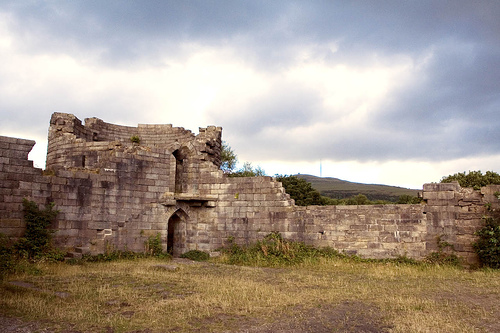


[Robert Browne's] sponsor, the earl, seems to have taken drama more seriously than any of the other noble sponsors of theatrical companies and was notably placed to do so.In addition to the Court, and all of Derby's Men's touring sites, and the Stanley manors at Knowsley, Lathom, and New Park where plays were known to have been performed, and in addition to the Boar's Head Inn and St. Pauls (and possibly the inn in Warrington), William Stanley was connected with at least two other theatrical sites. [1]The Boar's Head Playhouse, by Herbert Berry


David George writes: [2]
What we know...about the Prescot playhouse is that it lasted for many years and was therefore sturdily built, stood on the "wast', and was used as a playhouse at least from 1595 to 1603 and probably till 1609. It comes as a surprise that anyone could build on the 'wast' (waste or town moss). Probably only the Earl of Derby could have authorized such use of the common land since the town moss lay outside the town boundaries.and:
Earl William may have been the financial backer of the Prescot Playhouse.


R. J. Broadbent writes: [3]
At the Castle of Liverpool (erected early in the thirteenth century), during its occupancy by the Molyneux family, and at the Tower (built circa 1252), in Water Street, formerly belonging to the Lathoms of Lathom, afterwards to the Stanley and Derby families, theatrical entertainments to amuse the ' lord and his lady,' their retainers and neighbours, were, doubtless, given by players and others when passing through Liverpool on their way to Chester, and the southern towns. As late as 1734 James, the tenth Earl of Derby, entertained at the Tower. 'It is ascertained,' mentions J. G. Underhill in his unpublished MSS., in the archives of the Liverpool Free Library,' that at a remote period, probably in the days of Queen Elizabeth, an apartment in the Castle was fitted up for the performance of plays for the amusement of my lord Constable and the officers of his retinue. It is also most likely that out of courtesy the mayor and the principal inhabitants were occasionally invited to partake of these diversions, but it does not appear if this primitive hall of Thespis was open for all who chose to resort thither.'


Notes
[1] It is likely that William would also have had theatrical resources available at the main locations of the final decades of his life, Bidston Hall in the summer and his Chester home in the winter, but I know of no specifics.
[2] "The Playhouse at Prescot", David George, in Dutton, Richard, Alison Findlay, and Richard Wilson. Region, Religion and Patronage : Lancastrian Shakespeare. Manchester: Manchester University Press, 2003.
[3] Broadbent, R. J. Annals of the Liverpool Stage, From the Earliest Period to the Present Time: Together with Some Account of the Theatres and Music Halls In Bootle and Birkenhead. New York: B. Blom, 1969.
